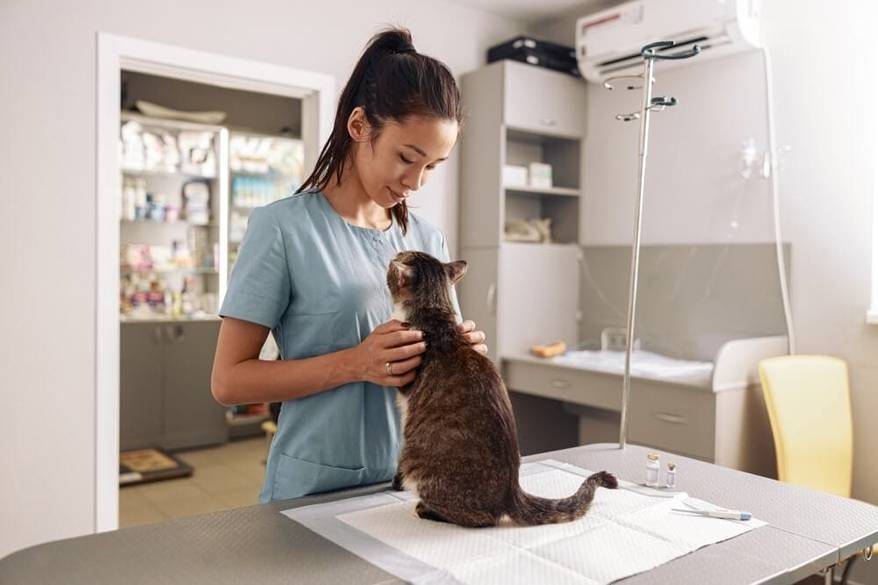
-
Find the right food for your pet
Take this quiz to see which food may be the best for your furry friend.
Find the right food for your pet
Take this quiz to see which food may be the best for your furry friend.
Featured products
 Adult Healthy Cuisine Roasted Chicken, Carrots & Spinach Stew Dog Food
Adult Healthy Cuisine Roasted Chicken, Carrots & Spinach Stew Dog FoodDelicious roasted chicken paired with tender vegetables in a succulent stew
Shop Now Small & Mini Savory Stew with Chicken & Vegetables Dog Food
Small & Mini Savory Stew with Chicken & Vegetables Dog FoodA delicious complement to the nutrition of Science Diet Small & Mini 7+ dog food
Shop Now Adult 7+ Perfect Digestion Chicken, Whole Oats & Brown Rice Recipe Dog Food
Adult 7+ Perfect Digestion Chicken, Whole Oats & Brown Rice Recipe Dog FoodScience Diet's breakthrough nutrition supports ultimate digestive well-being & healthy microbiome for dogs age 7+
Shop NowFeatured products
 Adult Savory Entrée Can Variety Pack Cat Food
Adult Savory Entrée Can Variety Pack Cat FoodPrecisely balanced nutrition with the delicious taste of savory minced chicken to help fuel the energy needs of cats during the prime of their life
Shop Now Adult 7+ Tender Tuna Dinner Cat Food
Adult 7+ Tender Tuna Dinner Cat FoodWith delicious chunks in a decadent gravy
Shop Now Adult 7+ Senior Vitality Chicken & Vegetable Stew Cat Food
Adult 7+ Senior Vitality Chicken & Vegetable Stew Cat FoodImproves Everyday Ability to Get Up & Go
Shop Now -
Dog
- Dog Tips & Articles
-
Health Category
- Weight
- Food & Environmental Sensitivities
- Urinary
- Digestive
- Joint
- Kidney
-
Life Stage
- Puppy Nutrition
- Adult Nutrition
- Senior Nutrition
Cat
- Cat Tips & Articles
-
Health Category
- Weight
- Skin & Food Sensitivities
- Urinary
- Digestive
- Kidney
-
Life Stage
- Kitten Nutrition
- Adult Nutrition
Featured articles
 Do Dogs and Cats have Belly Buttons?
Do Dogs and Cats have Belly Buttons?Learn whether cats & dogs have belly buttons like humans, what the function is, and if there are any health concerns associated with it.
Read More Why Are Dogs and Cats So Cute?
Why Are Dogs and Cats So Cute?If waggy puppy dog tails and furry kitten yawns make you swoon, you're not alone. Why are cats so cute? And, dogs too! Let's find out!
Read More Does My Pet Hate Me?
Does My Pet Hate Me?Learn tips for bonding with your pet if you've ever thought, 'My dog doesn't like me, or 'Why do I have a standoffish cat?'
Read More -


The moment you realize your beloved furry friend is lost is a helpless feeling. And, according to one study, 15% of cats and dogs go missing every year. Fortunately, technology such as microchips can help you recover your pet if they ever get lost. So, should you microchip your pet? Read on to learn everything you need to know to decide whether microchipping is right for your cat or dog.
Microchipping Your Pet
Microchipping your pet is one way to increase the odds that you'll reunite with your furry friend should they ever go astray. To microchip your pet, your veterinarian places a small, sterile computer chip (about the size of a grain of rice) under the loose skin between their shoulder blades.

Insertion
The whole procedure takes just a few seconds. Your vet will clean the skin where they want to inject the microchip and then quickly insert the chip under the skin with a needle. A microchip needle is larger than a vaccination needle, and it does cause discomfort for a second or two. Some vets will use local anesthesia when inserting the microchip, while others will use distraction techniques such as offering treats or letting your pet lick a delicious substance (e.g., peanut butter) off a lick mat. Alternatively, your vet can microchip your pet while they're asleep for a spay or neuter procedure. Talk to your vet about your options.
There's no recovery time after microchipping, so your cat or dog can go about their day as normal! Rarely, they may experience soreness or swelling at the injection site. If you notice swelling, call your vet.
Cost
Microchipping can be done at your local veterinary office. Many animal shelters and low-cost and mobile health clinics also offer microchipping, sometimes at a lower price. The cost of microchipping varies, but, on average, the procedure costs between $30 and $60. Some microchip companies charge an additional fee to store your contact information, so confirm costs ahead of time. If you're concerned with cost, ask your veterinary clinic if they'll implant the microchip during a technician visit (where your pet doesn't receive a physical from a vet).
How Microchips Work
A microchip contains a serial number unique to your pet, and it's associated with a phone number that belongs to the registry that owns the chip. A vet or pet care provider uses a handheld scanner to read the chip. Then, they call the number of the company and provide them with the serial number to retrieve your contact information, such as your name, address and phone number.
Limitations
Microchipping pets can help reunite furry friends with their families, but the technology does have limitations. For example, if you move or your phone number changes and you don't notify the microchip company, your pet's microchip will provide outdated information. Always update your contact details as soon as possible after a change.
Also, while microchips are always inserted between the shoulder blades, gravity can sometimes cause the chip to travel to another part of your pet's body, making it difficult for a scanner to find. Ask your vet to scan the chip at least once a year to make sure it's still where it should be. Finally, a microchip isn't a GPS. It can't tell you where your pet is unless they're found.
Because of these limitations, always attach a tag with your updated contact information to your dog's or cat's collar.


Tasty Tips
Young pets may need several visits in their first year for vaccinations. Adult pets generally benefit from annual check-ups, while senior or special-needs pets might require more frequent visits.
Shelters and Microchipping Pets
Many animal shelters require pets to have microchips before moving to their forever home. If you're planning to adopt a dog or cat from a local shelter, ask if the shelter microchips pets before adopting them out. Have the shelter run through the details of the program with you and explain what to do if your new pet gets lost.

The Future of Pet Identification
While microchipping pets is the most common way of reuniting pets with their families, GPS and QR code options are also available.
GPS Tracking
You can get a collar with a GPS unit to track your pet's location at all times. With GPS tracking, you can see your pet's whereabouts right on your smartphone. Many products are available, and they all have different capabilities and drawbacks. Here are some questions to ask yourself when shopping for these products:
- Do you have to sign up (and pay for) a subscription plan?
- How large is the tracking radius?
- How much does the collar weigh?
- How long does the battery last? Are the batteries rechargeable?
- Is the collar waterproof?
- Does your pet weigh enough for the tracker to work?
QR-Coded Tags or Collars
Fitting your dog with a collar or tags that have a QR code allows anyone with a smartphone to scan the code and find out where your pet belongs. These codes can also store alternative contact numbers and information, such as your dog's or cat's name, age, medications and allergies.
What to Do if Your Pet Gets Lost
Microchips can help you reunite with your lost dog or cat, but a few other simple steps can increase your odds of finding them. Always make sure your pet is wearing their collar with updated information on their ID tag, and keep updated photos of your pet to show to people in your area if they get loose. Other tips include:
- Call your local vets, shelters and animal control to let them know you have a lost cat or dog.
- Use social media to spread the word. Include a photo and description of your lost pet along with their last known location.
- Post lost pet signs on telephone poles and other areas around your neighborhood (old school but still effective!).
- Drive around the area where they were last spotted and keep your eye on areas you know they love (squirrel-filled parks, etc.).
While new ways of identifying lost pets could end up being the go-to in the future, microchips are currently the most common way of identifying a lost pet without ID tags. Microchipping is safe and relatively inexpensive, and most shelters will scan pets for a microchip immediately upon arrival. So, should you microchip your pet? Why not! Your pet is family, and they belong with you. A microchip is one more tool you can use to make sure they come home safe and sound.


Dr. Sarah Wooten graduated from UC Davis School of Veterinary Medicine in 2002. A member of the American Society of Veterinary Journalists, Dr. Wooten divides her professional time between small animal practice in Greeley, Colorado, public speaking on associate issues, leadership, and client communication, and writing. She enjoys camping with her family, skiing, SCUBA, and participating in triathlons.
Related products
Related articles

Check out our list of pet-friendly U.S. cities that are excellent travel options, offering off-leash dog parks and pet-friendly restaurants & hotels.

Crystals in your pet's urine can be common, but can also indicate a deeper health concern. Learn about the different types of crystals & what they mean.

Learn about veterinary dental care for your pet, including deep teeth cleaning procedures, which can help your dog or cat maintain proper dental health.

Learn the ins and outs of a televet appointment before you talk to a vet online.

Put your pet on a diet without them knowing
Our low calorie formula helps you control your pet's weight. It's packed with high-quality protein for building lean muscles, and made with purposeful ingredients for a flavorful, nutritious meal. Clinically proven antioxidants, Vitamin C+E, help promote a healthy immune system.
Put your pet on a diet without them knowing
Our low calorie formula helps you control your pet's weight. It's packed with high-quality protein for building lean muscles, and made with purposeful ingredients for a flavorful, nutritious meal. Clinically proven antioxidants, Vitamin C+E, help promote a healthy immune system.

